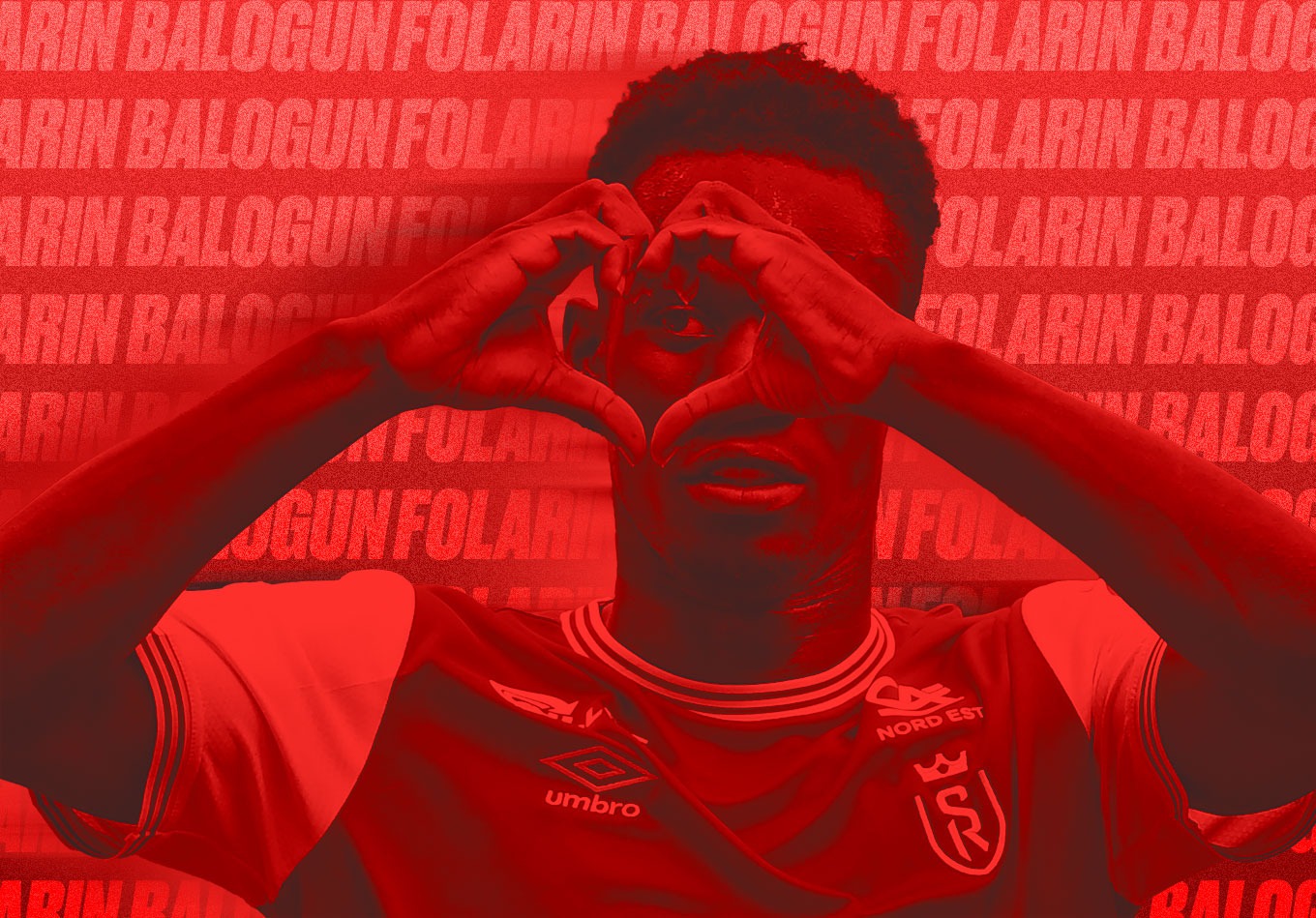When big clubs loan their youngsters out, it doesn’t always work out that well. A common outcome is a loaned-out player sitting on the bench at a relegation-battling side that plays in a style diametrically opposite to their parent club’s, and it can cost the player a year of their development at a crucial stage.
Folarin Balogun’s spell at Stade Reims might be an example on the other end of the spectrum. The Arsenal-owned striker and table tennis expert has scored 17 goals in Ligue 1 this season so far, with only Jonathan David and Kylian Mbappé scoring more with 19 each. He’s scored 47% of Reims’ goals this season and has been integral in Reims’ success this season under Will Still (not short for William Stilliam, unfortunately).
Balogun’s breakout season seems to have come out of nowhere, which raises the question of whether this is for real or a blip. Let’s take a deep dive into Balogun’s performance at Reims to figure that out.
But first, it’s crucial to consider the context of Reims and the tactical setup Balogun plays in, as it has large implications on his performance.
Click the links below to navigate to each section, or continue reading.
• Future with England and Arsenal
Will Still’s Reims
Are you on Twitter or Instagram? Oh, if so, did you hear that Will Still’s 30? Did you? And did you hear that he played Football Manager? And that Reims pay a £22,000 fine each game because Still doesn’t have his UEFA Pro License yet? Did you? Did you?
But football news aggregators aren’t the only beneficiaries of Will Still’s coaching at Reims. With Still at the helm, Reims have only lost one game in the league, and now sit ninth in the table. What’s more, they’re doing it with an eye-catching style of football. A lot of the goals they score tend to look like this:
If you lose the ball to Reims in the middle of the park, expect them to punish you swiftly and decisively. With an average attacking speed of 1.9 metres per second, Reims move the ball faster up the pitch in the league than any Ligue 1. They don’t pass the ball around much, averaging just 2.8 passes per possession sequence, but quickly turn those passes into shots with just 29 passes needed to generate a shot, the lowest in the league.
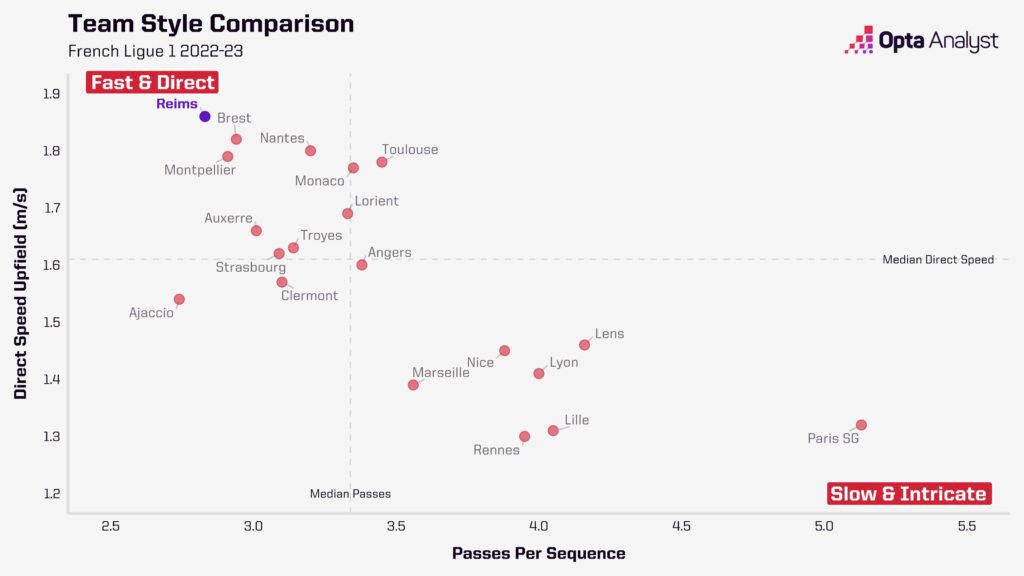
And this attacking pace is built on what they do without the ball. They press the opposition intensely high up the pitch with hybrid marking and look to win the ball back as soon as they lose it with an aggressive counter-press. Reims win the fourth-most high turnovers in the league (242), and naturally, winning the ball high up means you have a lot more space to attack quickly. 41 of Reims’ high turnovers have turned into shots, the fourth-most in the league.
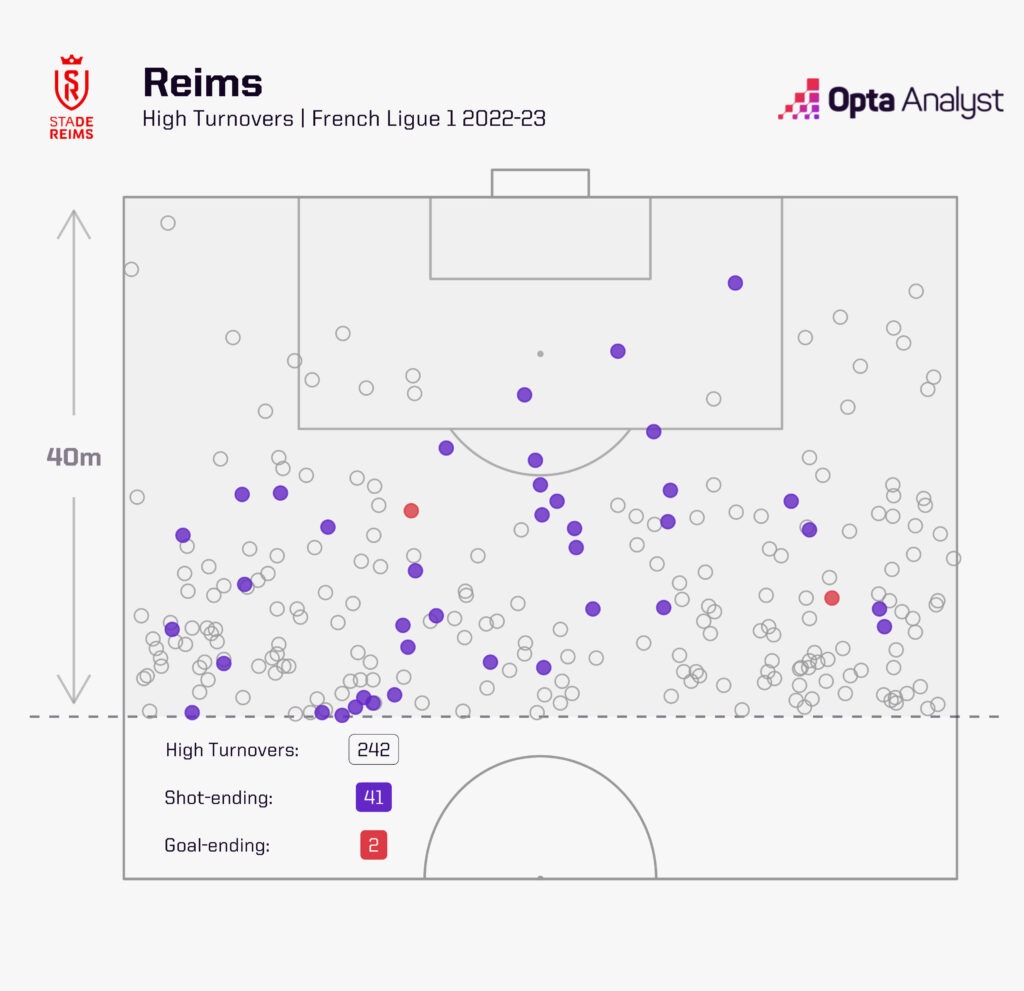
When Reims settle into a mid-block, they stay narrow and compact and try to deny space centrally and force the opposition to go out wide or out long. With a 4-4-2-ish shape, the two forwards cut off passing lanes into central midfield. As the opposition move further upfield, Reims’ forwards remain high up, becoming options for the out-ball if and when they win the ball back.
Intuitively, what all this means is that Balogun has a lot of pressing and defensive responsibilities off the ball. And then, once Reims win the ball back, he can get on the end of passes into space in transition with lots of room for chances in good areas.
But the implications of his team’s context don’t end there.
One interesting thing about Reim’s counter-attacks is where the longest, most direct pass in the counter-attacking move goes. Several of their successful counter-attacks, including most counter-attacks that lead to shots, involve direct balls to the central areas which Balogun inhabits. The fact that they win the ball back in central, advanced areas certainly helps.
It’s difficult to figure out whether this is an intentional counter-attacking strategy, or whether it’s just a case that successful long passes to central areas, while difficult to get right, lead to better counter-attacks. The safer explanation is that it’s the latter.
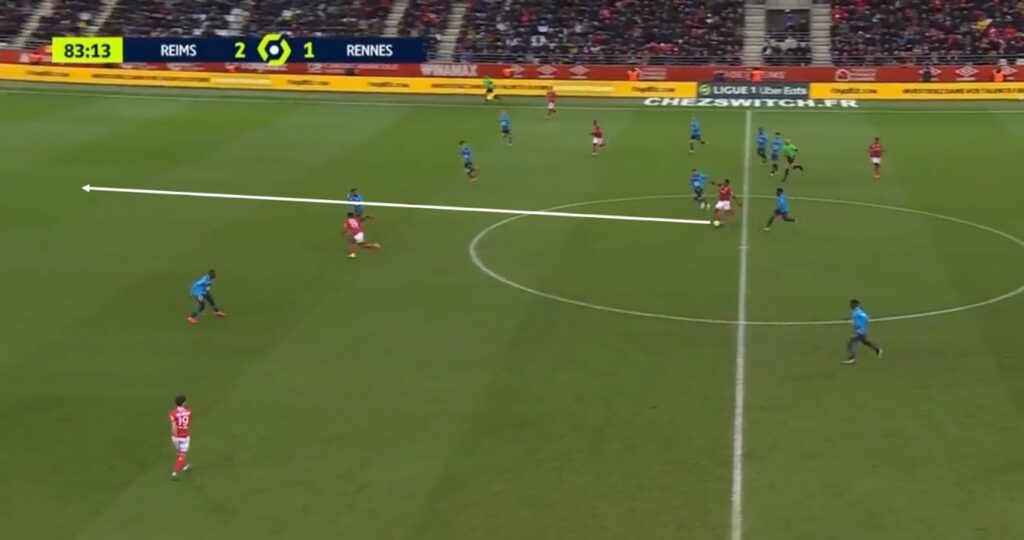
Nevertheless, what it means is that Balogun ends up being involved in most direct attacks, either tasked with running in behind or holding it up. This means he has to act as the fulcrum for many of Reims’ counter-attacks.
Reims’ moves from settled possession aren’t usually very intricate. For one, they don’t enjoy long spells of settled possession – they have the fewest possession sequences that are made up of 10 or more passes in the division.
When building up they tend to have more players on one side of the pitch than the other – which helps with counter-pressing – and attack in numbers, with full-backs eager to overlap. When they get there, they’re fairly direct in the final third, which means Balogun’s usually high up the pitch, looking for sharp passes in behind the defence.
Lastly, a bit like a 2010s Roger Schmidt side, after Reims win the ball high up and quickly move up the pitch, unless there’s a clear way into the heart of the opposition box, they tend to shoot early. They take the most shots from outside the box in the league with 5.5 per game, and it makes up 39% of their total shot count.
As you can see in their shot map, while they take several high-quality shots from close to the goal, usually because of the space available to them on the counter-attack, they also have a large cluster of shots from outside the box and from the wider areas of the box.
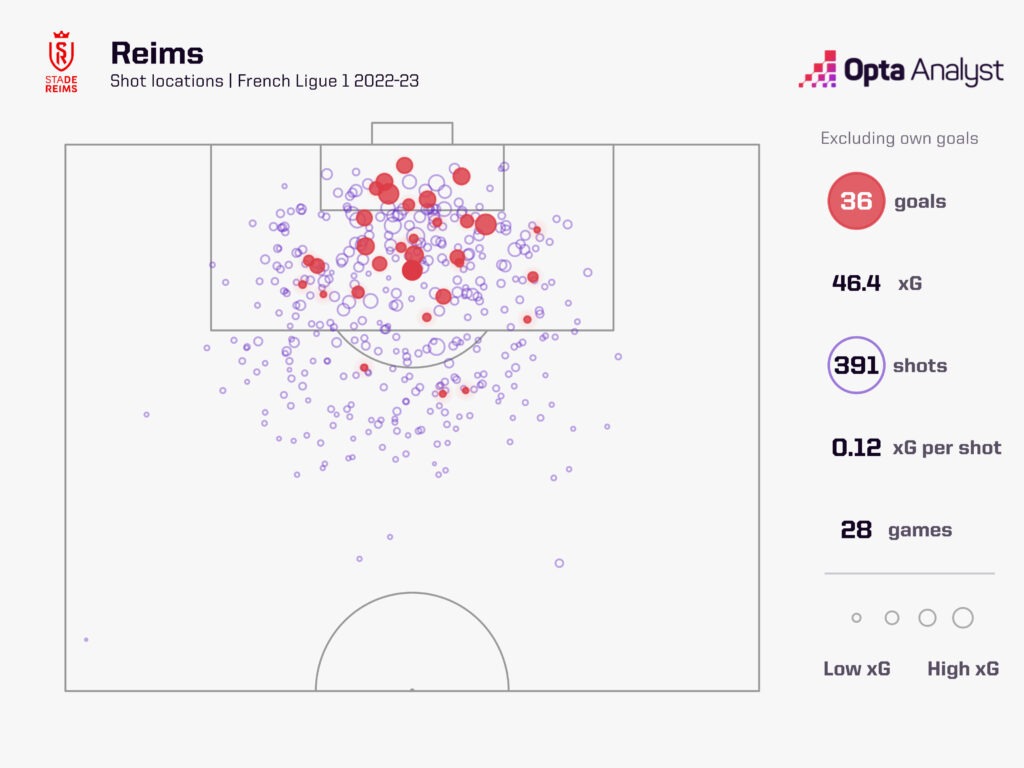
All in all, this indicates that Balogun’s performance at Reims is inextricably linked to the tactical system he plays in. Which takes us to the crux of the matter.
Balogun at Reims
Shooting
Balogun’s goalscoring isn’t a flash in the pan. It’s a result of his ability to consistently create good chances for himself. His non-penalty expected goals (xG) per 90 minutes of 0.62 (the third-highest in the league) exceeds his actual goal tally (0.55 non-penalty goals per 90 minutes, the 12th-highest in the league).
Among Ligue 1 players who’ve played at least 900 minutes, only Kylian Mbappé and Lionel Messi take more shots in the league than Balogun’s 3.6 per 90 minutes. High shot volume is a great sign for young forwards. What’s more, he has an impressive xG per shot of 0.22. That’s because his shots come from transitions but more importantly, because of the quality of his off-ball movement – more on that in a bit.
Looking at his shots individually shows some interesting tendencies. Balogun takes several shots from the wide areas of the box, in the areas circled in this shot map.
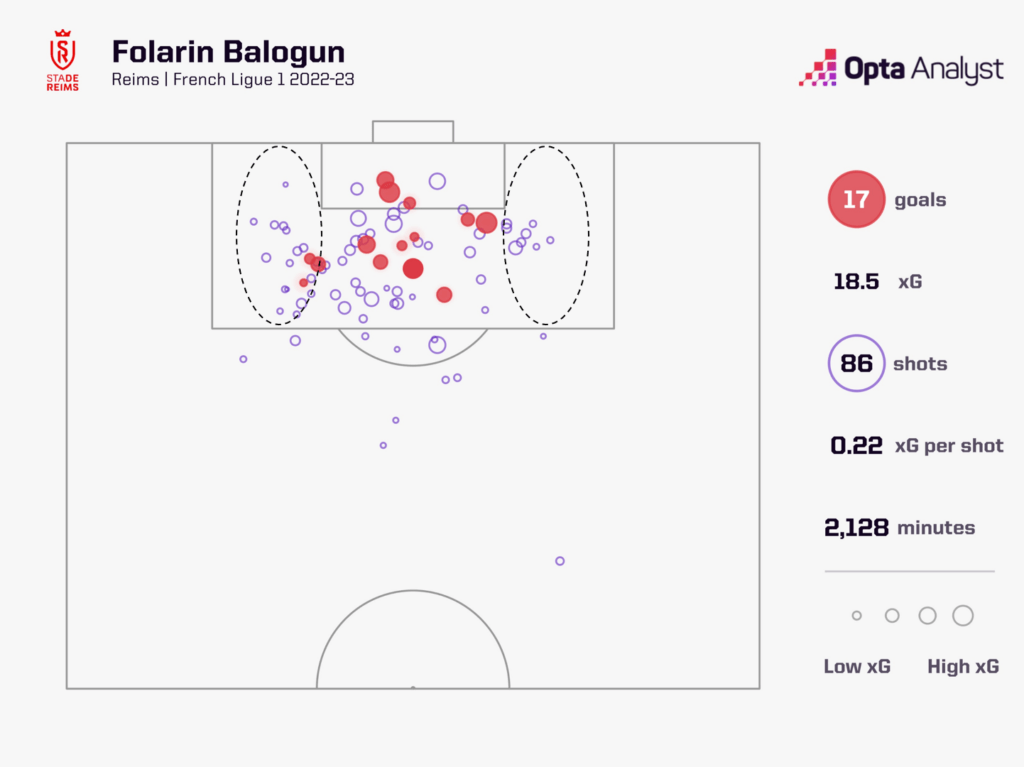
As Peter Munnelly writes for Scouted Football, Balogun’s first touch may be to blame for this, with heavy first touches taking him too wide and making him less likely to score. This is the one major flaw that his shot profile reveals.
Aside from that, what his shots show is the fact that he’s created quite a few of them himself on the dribble. Balogun’s made the fourth-most carries that end in a shot (22) and is a good dribbler who works the ball out of tight situations and into the box with feints, fake shots, and neat turns.
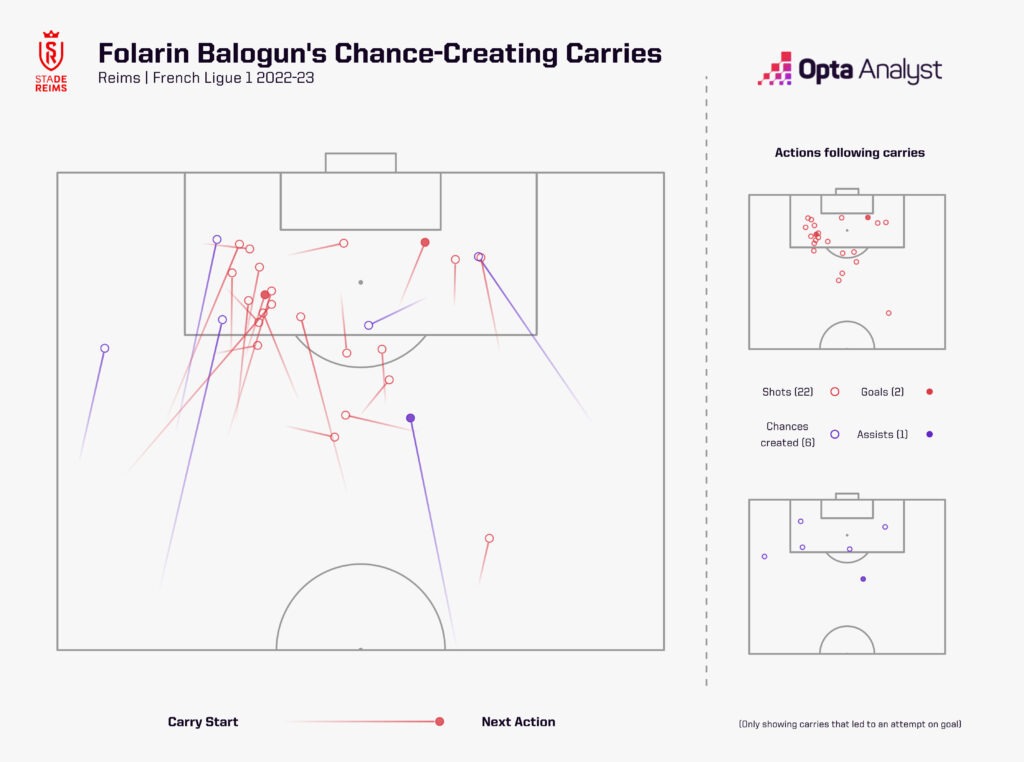
This, along with his ability to generate pure shot volume, indicates that he can create several chances for himself from the final third irrespective of the service he receives. This is a wonderful sign that can help him thrive in different contexts.
Lastly, there is the question of his finishing. While most of his goals involve good finishes, he still misses quite a few high-quality chances in the central areas of the box. This shows up in the data, too. His post-shot expected goals on target (xGOT), which also factors in shot placement, is 5.2% lower than his pre-shot xG total, indicating that he slightly decreases his chances of scoring because of his shooting. While this is a concern, it’s not clear whether this is a trend that’ll continue, and more importantly, the fact that he creates tons of high-quality chances for himself far outweighs the marginal consequences of sub-par finishing.
Clearly, despite some nuances, Balogun’s catalogue of shots reveals lots to be optimistic about. But what comes right before most of his shots tells an even more important story.
Movement and Positioning
Any direct attacking side needs attackers to run in behind the defence, and Reims are lucky to have Balogun on the end of their through balls and long passes. He has the pace and off-ball intelligence to make any centre-back question the concept of the high line.
It’s something that Balogun himself has talked about. “I spend a lot of time analysing places I should be in the box and where I can find space.”, he told The Ligue 1 Show’s Matt Spiro. “And I mean even when I’m watching football games just at home, of course a part of me watches them just as a fan, and I’m just as intrigued in football as anyone is, but I’m also looking to see why certain players, the ball always lands to them.”
As you’d expect, when Reims have the ball, Balogun spends a lot of his time high up the pitch on the shoulder of the last defender. A sky-high 19% of his open-play touches occur in the opposition’s box. But at the same time, he does often move out wide and drops deep when he’s a viable passing option, making him well-rounded off the ball.
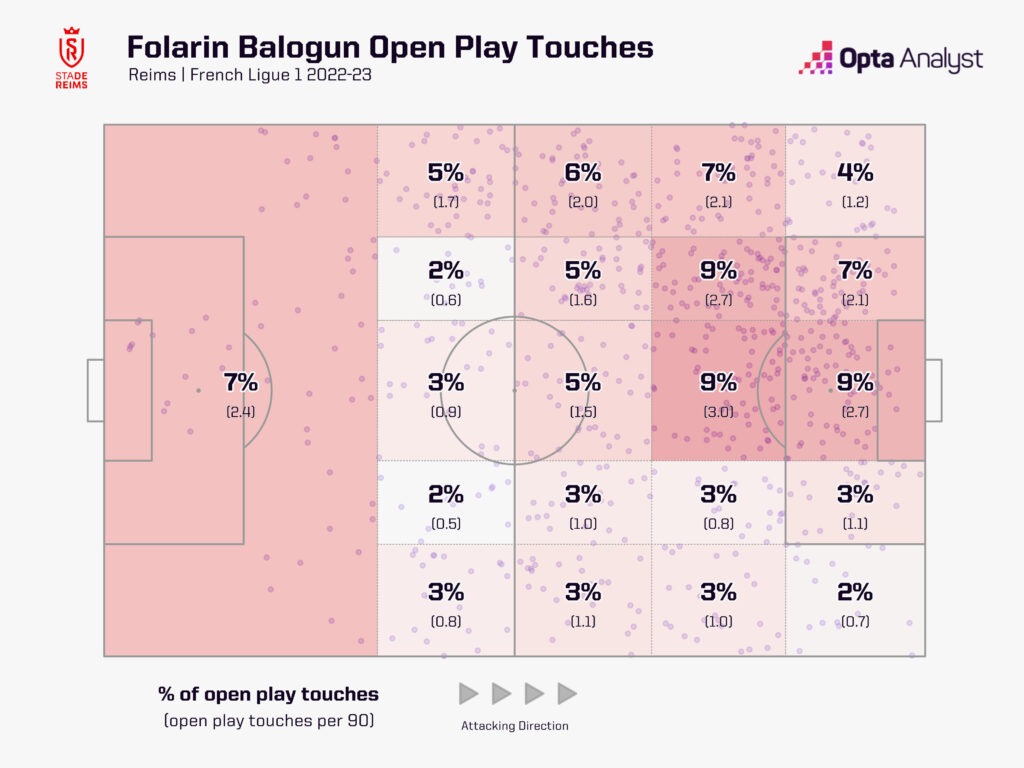
Running in behind nevertheless remains his speciality. For starters, his pure pace helps him win any footrace.
But at the same time, he shows great positional intelligence when running in behind, outwitting defenders and creating space for himself. While most of his current examples are against unsettled defences, Balogun often curves his runs successfully to get into space.
His movement for meeting crosses is generally successful, often switching lanes, delaying his run, or making quick dashes to the near post, as he does here.
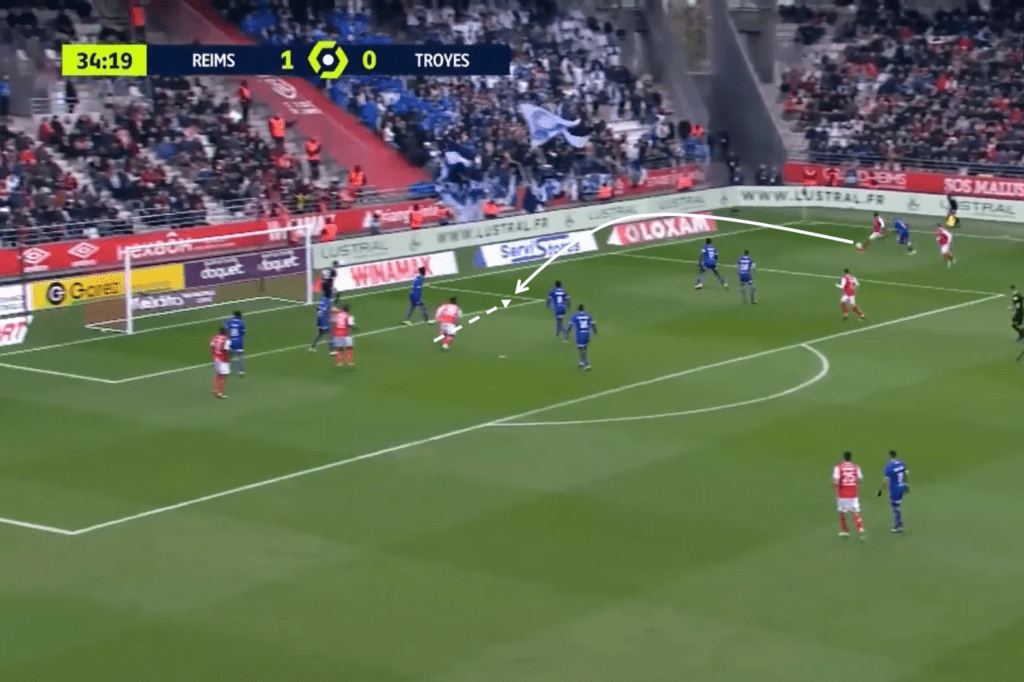
In general, Balogun has the positional intelligence and timing of runs you’d want from a goalscorer as well as tons of pace to support it. You do not want to be marking this guy near the halfway line.
Counter-Attacking
Reims are a direct attacking side, and they require a frontman who’s well-suited to conducting counter-attacks. As mentioned, many of their successful counter-attacks involve long, direct passes into Balogun’s area of the pitch.
This shows up in the data, too. As you can see in this map of the passes Balogun receives before he shoots, many of the final balls he’s on the end of are long, direct vertical passes from deep. He consistently needs to turn vertical passes, usually out-balls in counter-attacking moves, into shots and goals.
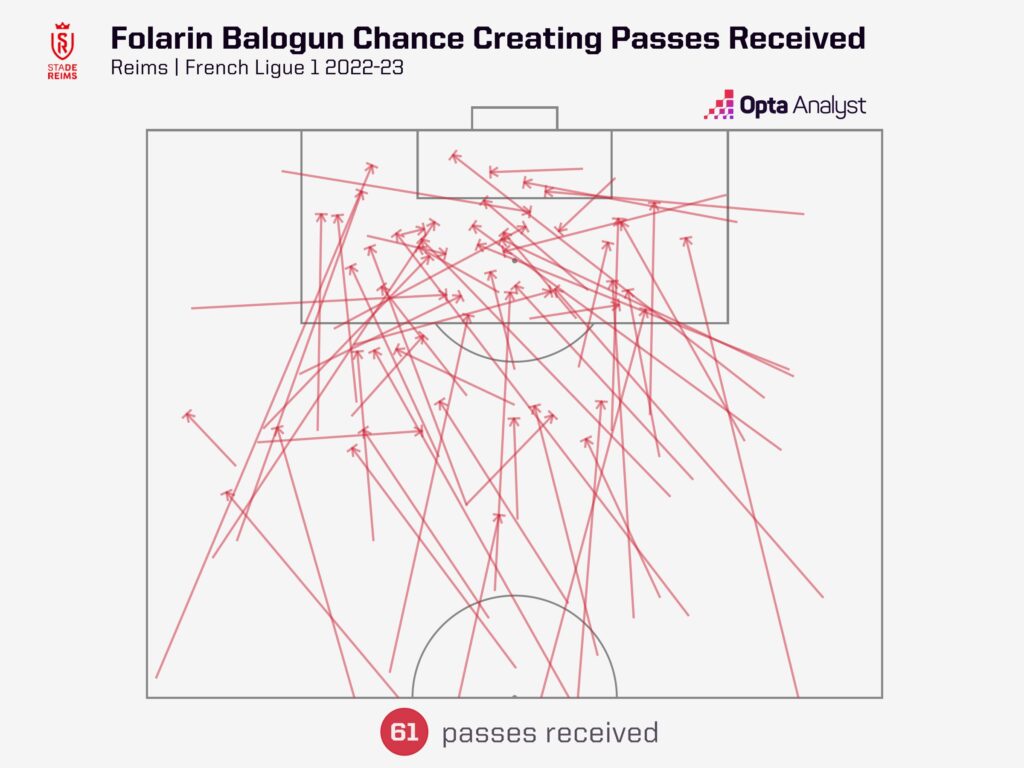
As a result, it’s a good thing that he seems adept at this. Most of Balogun’s goals involve him chasing through balls in behind the opposition’s defence from counter-attacks, but aside from that, he helps Reims get up the pitch quickly when they counter-attack even when he doesn’t score.
Firstly, Balogun holds the ball up well to get his team-mates involved in a counter-attacking sequence.
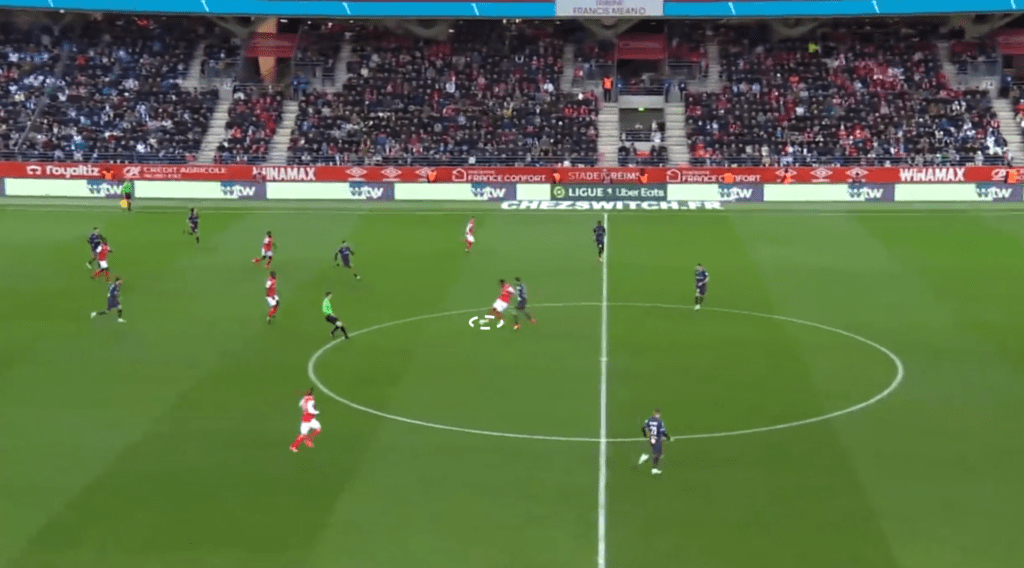
He also plays several flick-ons and one-twos on the counter, allowing quick progression down a vertical lane.
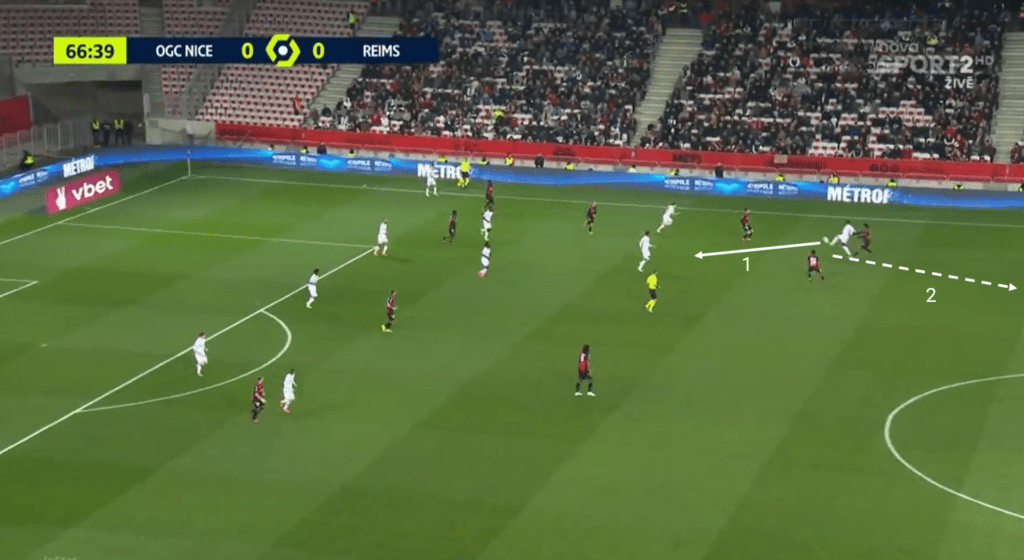
Plus, Balogun tends to fill the right lanes and channels in counter-attacking moves, helping Reims maintain the right width and spacing for successful counter-attacking. He seems comfortable on the left flank, perhaps owing to the fact that he started out as a winger at youth level, occasionally even getting into crossing positions from the wings on the counter.
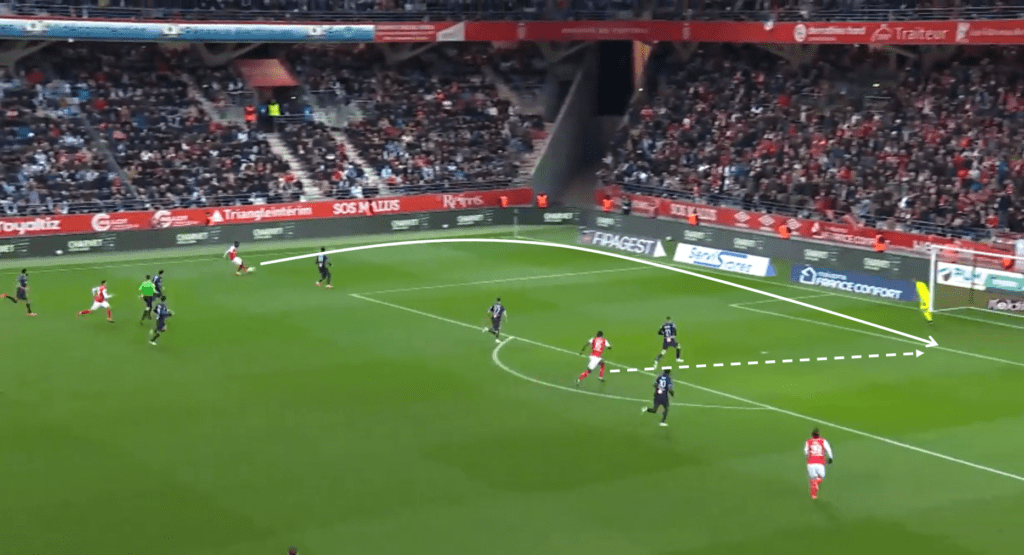
In summary, it’s very clear that Balogun’s main strength is playing on the counter, whether he’s conducting the counter-attack or putting in the final touch, and that makes him a perfect fit for Reims’ system.
Pressing
As we discussed earlier, Reims look to win the ball high up the pitch and counter-press aggressively. Naturally, their striker is a key part of what they do without the ball.
Balogun’s defensive numbers don’t look like much to talk about. He’s only won six tackles and two interceptions throughout the season (a combined 0.33 per 90 minutes), but what Balogun really does goes beyond the numbers. While Balogun rarely wins the ball back on his own, he’s energetic and dynamic out of possession, leading the pressing pack and helping Reims win the ball back high up the pitch. He tends to commit himself to winning the ball back from the ball carrier, occasionally overzealously, and help his team-mates around him win the ball in advanced areas.
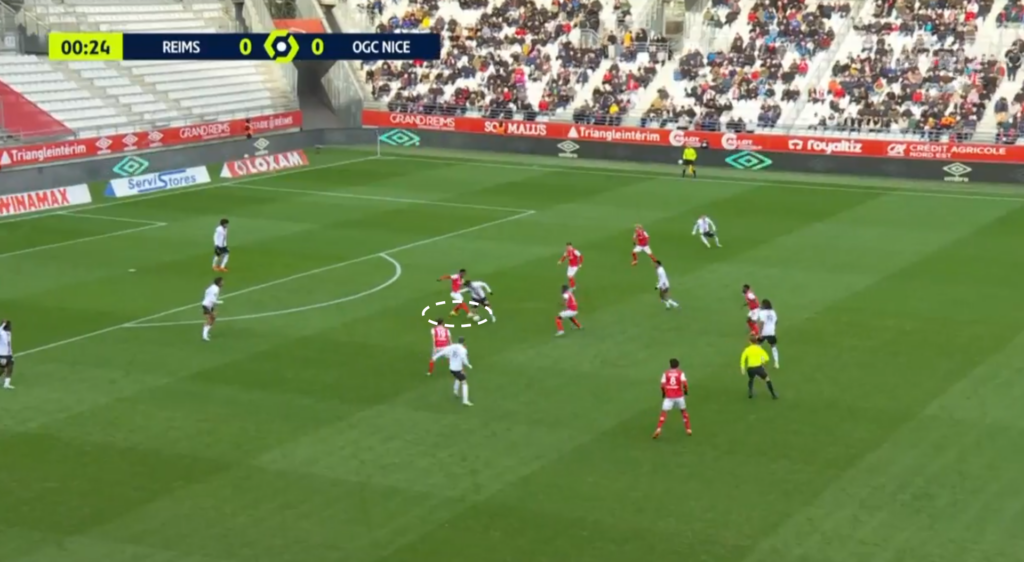
With his pace, Balogun also hunts down loose passes played in his territory very well.
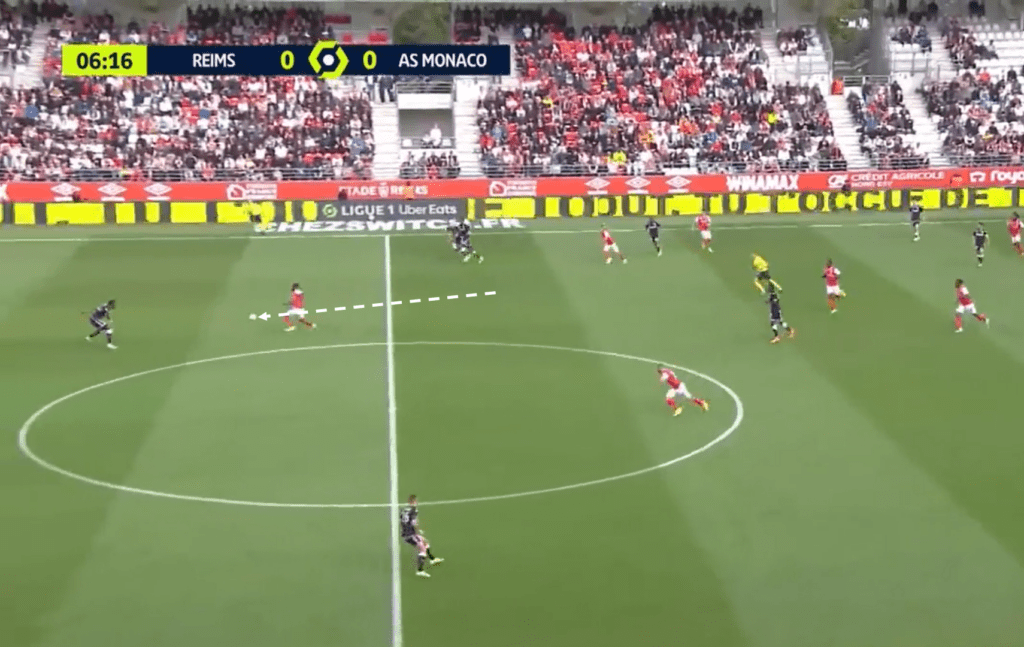
Sitting in their mid-block, Reims constantly force the opposition out wide. Balogun engages the opposition defender with the ball on his side of the pitch and wins it back or funnels the opposition out wide.
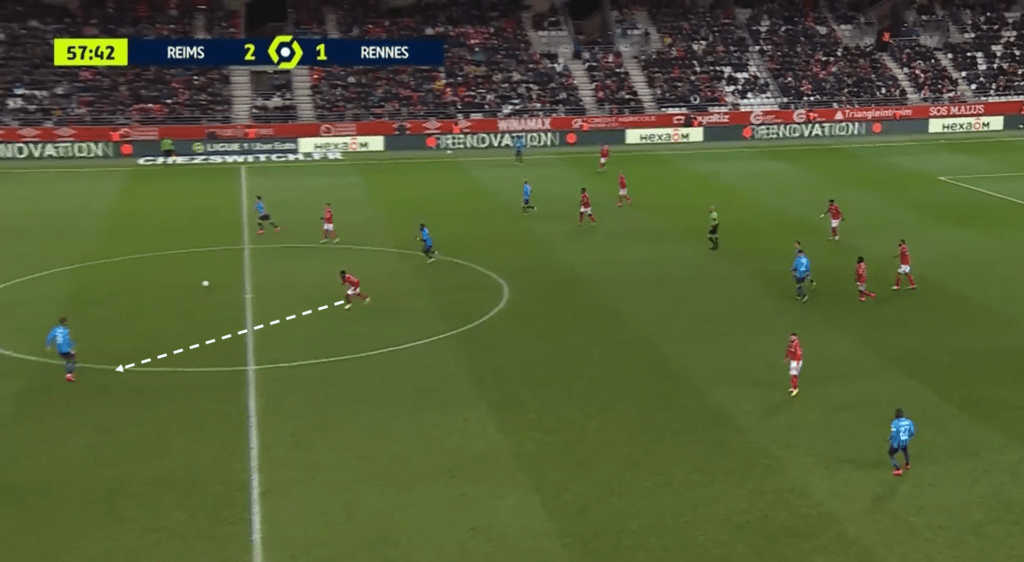
When the ball passes Balogun, he doesn’t remain idle, either. He often tracks back to help win the ball back in wide, deep areas, even if he doesn’t win the ball back on his own (although he does win the ball back in the following instance).
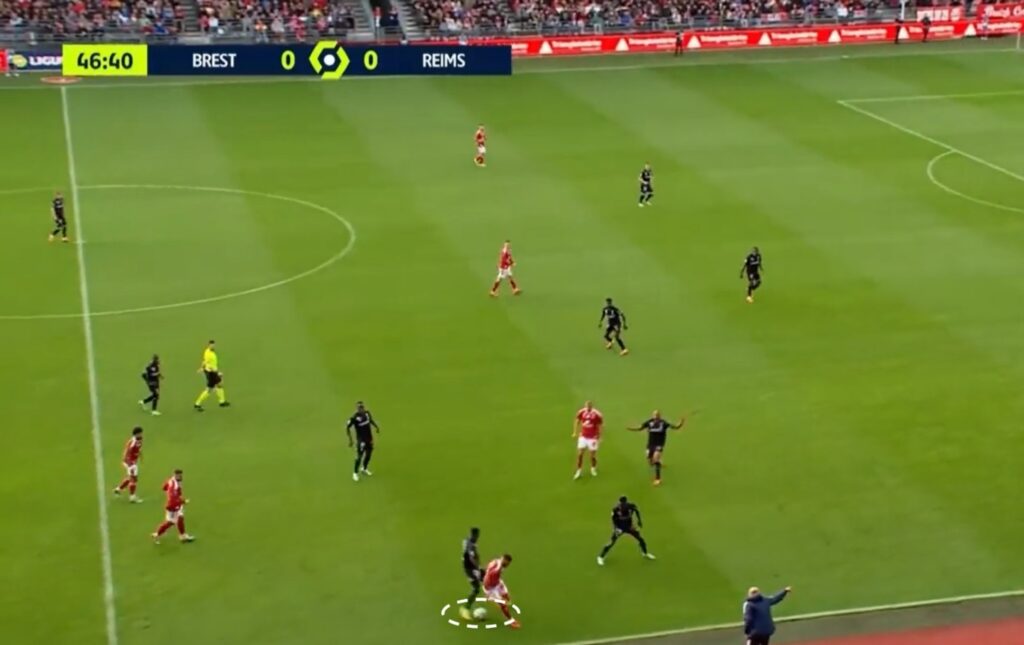
Balogun is an integral part of Reims’ pressing and defending, and this should translate to any system he plays in.
Passing and Link-up Play
This one’s a mixed bag. In general, while his default position is much higher up, Balogun does often drop deep and make himself available in passing moves, and he’s seemingly been dropping deeper recently, as opponents sit progressively deeper against Reims.
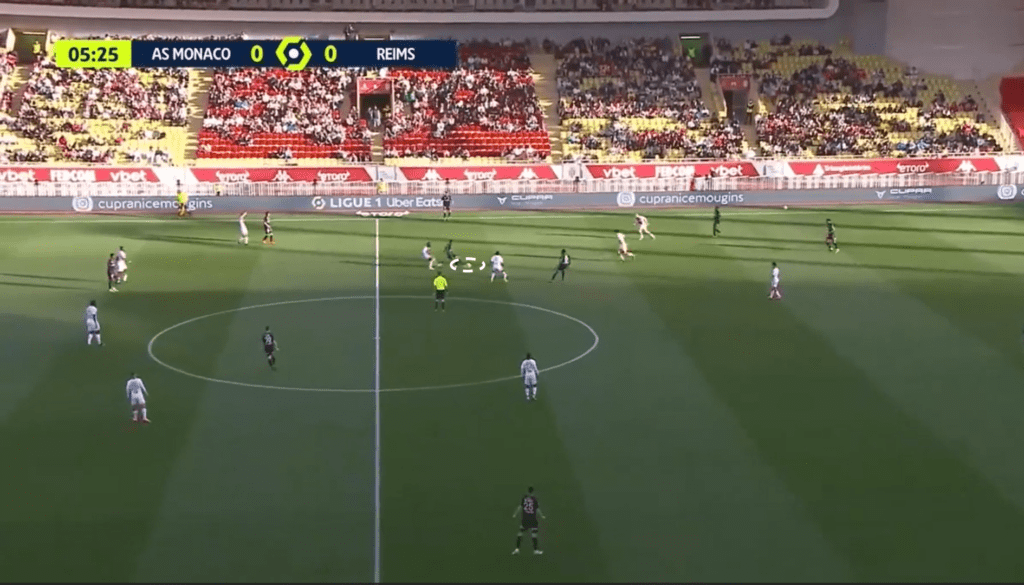
Balogun seems adept at playing one-touch flick-ons and wall passes with his feet and opts to play those passes often. He uses his body well to hold off defenders, and once again, this is a great asset when Reims attack directly.
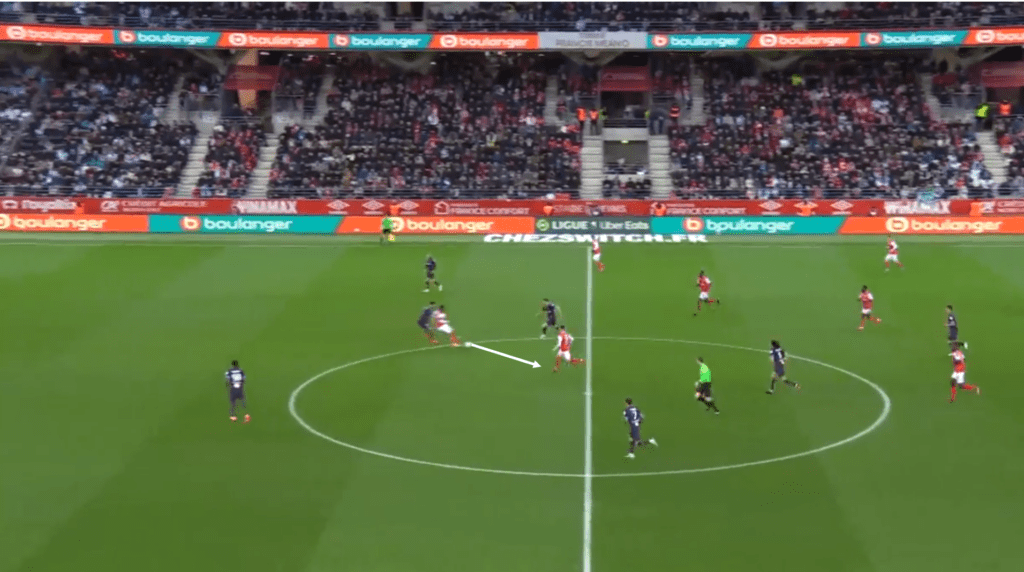
Plus, as we touched upon in the section on counter-attacks, from wide positions, Balogun executes cross-field switches and crosses fairly well.
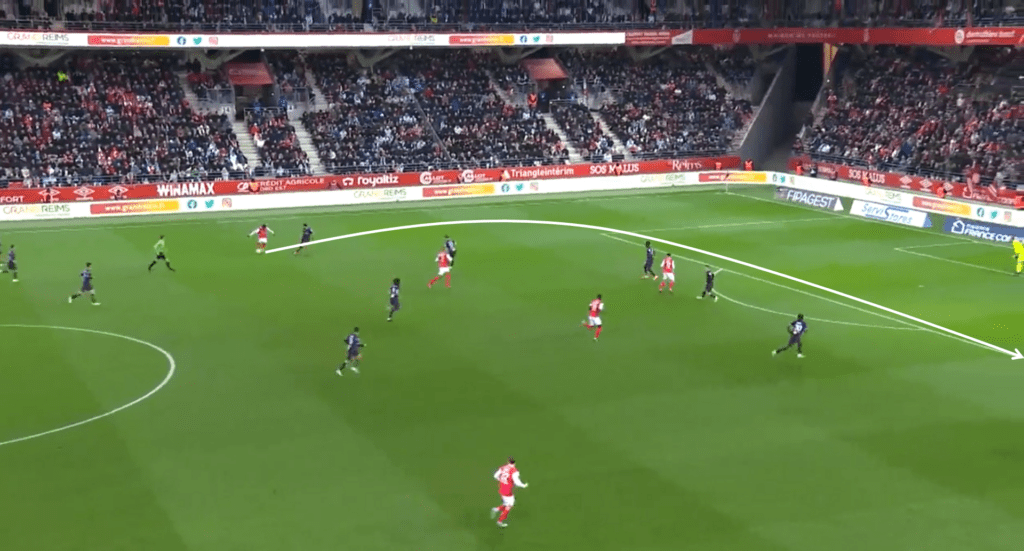
That being said, there is one general flaw in his passing: the weight. Many of his passes are imbalanced and can kill the tempo of the attack. This is an issue that generally reveals itself during settled possession and puts his translatability into high-possession sides under question.
All in all, while his work on the ball works very well for his current context, some of his shortcomings in link-up play can hinder him in a less transition-heavy tactical system.
Future With Arsenal and England
Of late, there’s been a lot of speculation over which national team – England, the United States, and Nigeria – Balogun chooses to represent. England manager Gareth Southgate addressed this recently, saying, “Flo, we like. He has not had an opportunity in the Premier League yet, so we have to weigh up those goals against Ivan [Toney’s] or Ollie Watkins’ or Eddie Nketiah’s.”
This question of translatability across leagues represents many people’s reservations about Balogun’s current performance. It’s a cliché that we hear all the time about Ligue 1 talents. But this shouldn’t be a major concern; Reims aren’t near the top of the Ligue 1 table, meaning that Balogun faces harder opposition relative to his team’s strength far more than, say, Arsenal’s strikers do, and Balogun faces a wide range of defensive styles in Ligue 1. But the one concern around translatability that probably should exist is that of moving between systems.
As we’ve seen throughout this piece, the skills that Balogun’s exhibited seems suited to Reims’ intense-pressing, counter-attacking style, and while Balogun shows tendencies – like the way he offers himself as an option when his team pass the ball around – that would work well in a high-possession side, a couple of shortcomings, like his passing weight, could mean that he’d take a while to adjust to a side that moves up the pitch with intricate passing. Most of his good chances and goals also arrive in counter-attacks against unsettled defences, and it’ll be interesting to see how he finds space in settled possession.
Plus, as the primary goalscoring threat at Reims who is the target of most of their attacks and final balls, Balogun could find goalscoring chances to come by a little harder at a bigger side with more goal threats. He’d certainly end up being less trigger-happy around the box and safer in possession, which is in contrast to his high-usage – which means he ends lots of his side’s possession sequences – performance at Reims.
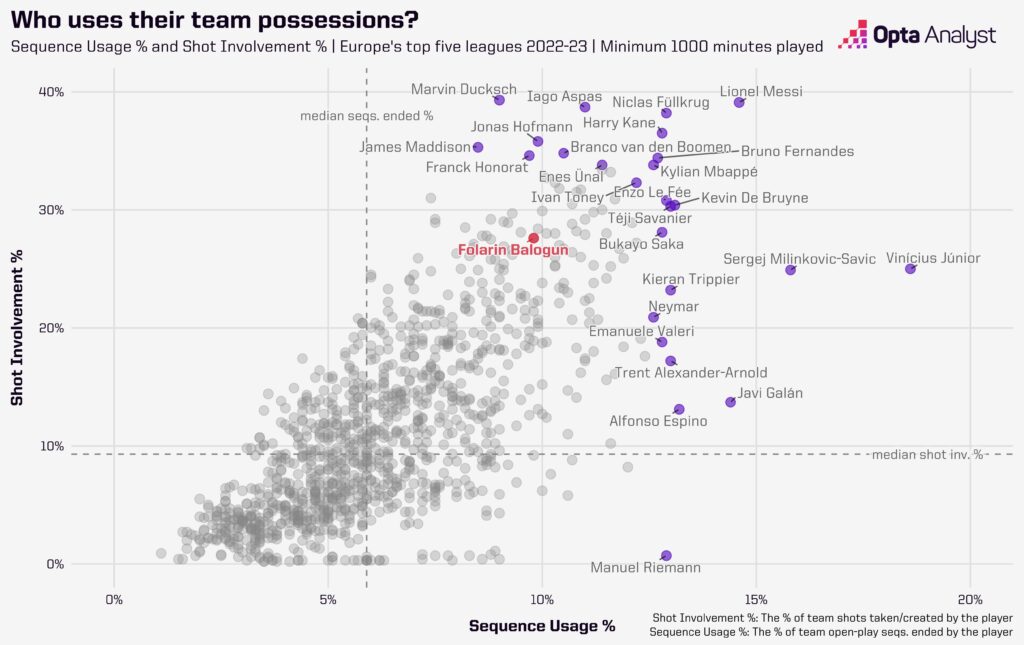
That being said, Balogun’s quality is obvious, and it’ll be interesting to see what Arsenal decide to do with him considering how Eddie Nketiah is another young striker with a similar profile. But for now, Balogun seems to be at the perfect place for the current step of his career at Reims.
A lot of the current social media discourse on Balogun is defined by question marks, from whether he’d make it at Arsenal to which national team he’ll end up choosing. But there’s absolutely no question about the ability and potential he possesses.
Enjoy this? Subscribe to our mailing list to receive exclusive weekly content. And follow us on Twitter too.
